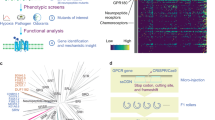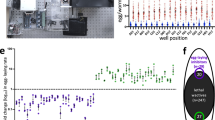Abstract
DEET (N,N-diethyl-meta-toluamide) is a synthetic chemical identified by the US Department of Agriculture in 1946 in a screen for repellents to protect soldiers from mosquito-borne diseases1,2. Since its discovery, DEET has become the world’s most widely used arthropod repellent and is effective against invertebrates separated by millions of years of evolution—including biting flies3, honeybees4, ticks5, and land leeches3. In insects, DEET acts on the olfactory system5,6,7,8,9,10,11,12 and requires the olfactory receptor co-receptor Orco7,9,10,11,12, but exactly how it works remains controversial13. Here we show that the nematode Caenorhabditis elegans is sensitive to DEET and use this genetically tractable animal to study the mechanism of action of this chemical. We found that DEET is not a volatile repellent, but instead interferes selectively with chemotaxis to a variety of attractant and repellent molecules. In a forward genetic screen for DEET-resistant worms, we identified a gene that encodes a single G protein-coupled receptor, str-217, which is expressed in a single pair of chemosensory neurons that are responsive to DEET, called ADL neurons. Mis-expression of str-217 in another chemosensory neuron conferred responses to DEET. Engineered str-217 mutants, and a wild isolate of C. elegans that carries a str-217 deletion, are resistant to DEET. We found that DEET can interfere with behaviour by inducing an increase in average pause length during locomotion, and show that this increase in pausing requires both str-217 and ADL neurons. Finally, we demonstrated that ADL neurons are activated by DEET and that optogenetic activation of ADL neurons increased average pause length. This is consistent with the ‘confusant’ hypothesis, which proposes that DEET is not a simple repellent but that it instead modulates multiple olfactory pathways to scramble behavioural responses10,11. Our results suggest a consistent motif in the effectiveness of DEET across widely divergent taxa: an effect on multiple chemosensory neurons that disrupts the pairing between odorant stimulus and behavioural response.
This is a preview of subscription content, access via your institution
Access options
Access Nature and 54 other Nature Portfolio journals
Get Nature+, our best-value online-access subscription
$29.99 / 30 days
cancel any time
Subscribe to this journal
Receive 51 print issues and online access
$199.00 per year
only $3.90 per issue
Buy this article
- Purchase on Springer Link
- Instant access to full article PDF
Prices may be subject to local taxes which are calculated during checkout





Similar content being viewed by others
Data availability
All scripts and graphed data with the exception of raw video files are available in the Supplementary Data. Raw video files are available on request from the corresponding author.
References
Travis, B. V. et al. The more effective mosquito repellents tested at the Orlando, Fla., laboratory, 1942–47. J. Econ. Entomol. 42, 686–694 (1949).
McCabe, E. T., Barthel, W. F., Gertler, S. I. & Hall, S. A. Insect Repellents. III. N, N-diethylamides. J. Org. Chem. 19, 493–498 (1954).
Tawatsin, A. et al. Field evaluation of DEET, Repel Care, and three plant based essential oil repellents against mosquitoes, black flies (Diptera: Simuliidae) and land leeches (Arhynchobdellida: Haemadipsidae) in Thailand. J. Am. Mosq. Control Assoc. 22, 306–313 (2006).
Abramson, C. I. et al. Proboscis conditioning experiments with honeybees, Apis mellifera caucasica, with butyric acid and DEET mixture as conditioned and unconditioned stimuli. J. Insect Sci. 10, 122 (2010).
Carroll, J. F., Klun, J. A. & Debboun, M. Repellency of DEET and SS220 applied to skin involves olfactory sensing by two species of ticks. Med. Vet. Entomol. 19, 101–106 (2005).
Dogan, E. B., Ayres, J. W. & Rossignol, P. A. Behavioural mode of action of DEET: inhibition of lactic acid attraction. Med. Vet. Entomol. 13, 97–100 (1999).
Ditzen, M., Pellegrino, M. & Vosshall, L. B. Insect odorant receptors are molecular targets of the insect repellent DEET. Science 319, 1838–1842 (2008).
Syed, Z. & Leal, W. S. Mosquitoes smell and avoid the insect repellent DEET. Proc. Natl Acad. Sci. USA 105, 13598–13603 (2008).
Liu, C. et al. Distinct olfactory signaling mechanisms in the malaria vector mosquito Anopheles gambiae. PLoS Biol. 8, e1000467 (2010).
Pellegrino, M., Steinbach, N., Stensmyr, M. C., Hansson, B. S. & Vosshall, L. B. A natural polymorphism alters odour and DEET sensitivity in an insect odorant receptor. Nature 478, 511–514 (2011).
DeGennaro, M. et al. orco mutant mosquitoes lose strong preference for humans and are not repelled by volatile DEET. Nature 498, 487–491 (2013).
Xu, P., Choo, Y. M., De La Rosa, A. & Leal, W. S. Mosquito odorant receptor for DEET and methyl jasmonate. Proc. Natl Acad. Sci. USA 111, 16592–16597 (2014).
DeGennaro, M. The mysterious multi-modal repellency of DEET. Fly 9, 45–51 (2015).
Bargmann, C. I. & Horvitz, H. R. Chemosensory neurons with overlapping functions direct chemotaxis to multiple chemicals in C. elegans. Neuron 7, 729–742 (1991).
Cho, C. E., Brueggemann, C., L’Etoile, N. D. & Bargmann, C. I. Parallel encoding of sensory history and behavioral preference during Caenorhabditis elegans olfactory learning. eLife 5, e14000 (2016).
Reeder, N. L., Ganz, P. J., Carlson, J. R. & Saunders, C. W. Isolation of a DEET-insensitive mutant of Drosophila melanogaster (Diptera: Drosophilidae). J. Econ. Entomol. 94, 1584–1588 (2001).
Stanczyk, N. M., Brookfield, J. F., Ignell, R., Logan, J. G. & Field, L. M. Behavioral insensitivity to DEET in Aedes aegypti is a genetically determined trait residing in changes in sensillum function. Proc. Natl Acad. Sci. USA 107, 8575–8580 (2010).
Brand, P. et al. The origin of the odorant receptor gene family in insects. eLife 7, e38340 (2018).
Cook, D. E., Zdraljevic, S., Roberts, J. P. & Andersen, E. C. CeNDR, the Caenorhabditis elegans Natural Diversity Resource. Nucleic Acids Res. 45, D650–D657 (2017).
Doroszuk, A., Snoek, L. B., Fradin, E., Riksen, J. & Kammenga, J. A genome-wide library of CB4856/N2 introgression lines of Caenorhabditis elegans. Nucleic Acids Res. 37, e110 (2009).
Bargmann, C. I., Hartwieg, E. & Horvitz, H. R. Odorant-selective genes and neurons mediate olfaction in C. elegans. Cell 74, 515–527 (1993).
Zaslaver, A. et al. Hierarchical sparse coding in the sensory system of Caenorhabditis elegans. Proc. Natl Acad. Sci. USA 112, 1185–1189 (2015).
Jang, H. et al. Neuromodulatory state and sex specify alternative behaviors through antagonistic synaptic pathways in C. elegans. Neuron 75, 585–592 (2012).
Schiavo, G. et al. Tetanus toxin is a zinc protein and its inhibition of neurotransmitter release and protease activity depend on zinc. EMBO J. 11, 3577–3583 (1992).
Richmond, J. E., Davis, W. S. & Jorgensen, E. M. UNC-13 is required for synaptic vesicle fusion in C. elegans. Nat. Neurosci. 2, 959–964 (1999).
Speese, S. et al. UNC-31 (CAPS) is required for dense-core vesicle but not synaptic vesicle exocytosis in Caenorhabditis elegans. J. Neurosci. 27, 6150–6162 (2007).
Lin, J. Y., Knutsen, P. M., Muller, A., Kleinfeld, D. & Tsien, R. Y. ReaChR: a red-shifted variant of channelrhodopsin enables deep transcranial optogenetic excitation. Nat. Neurosci. 16, 1499–1508 (2013).
Brenner, S. The genetics of Caenorhabditis elegans. Genetics 77, 71–94 (1974).
Stiernagle, T. in WormBook (ed. The C. elegans Research Community, WormBook) https://www.doi.org/10.1895/wormbook.1.101.1 (2006).
Mello, C. & Fire, A. DNA transformation. Methods Cell Biol. 48, 451–482 (1995).
Arribere, J. A. et al. Efficient marker-free recovery of custom genetic modifications with CRISPR/Cas9 in Caenorhabditis elegans. Genetics 198, 837–846 (2014).
Hart, A. C. (ed.) in WormBook (ed. The C. elegans Research Community, WormBook) https://www.doi.org/10.1895/wormbook.1.87.1 (2006).
Sarin, S. et al. Analysis of multiple ethyl methanesulfonate-mutagenized Caenorhabditis elegans strains by whole-genome sequencing. Genetics 185, 417–430 (2010).
Zuryn, S., Le Gras, S., Jamet, K. & Jarriault, S. A strategy for direct mapping and identification of mutations by whole-genome sequencing. Genetics 186, 427–430 (2010).
Kutscher, L. M. & Shaham, S. in WormBook (ed. The C. Elegans Research Community, WormBook) https://doi.org/10.1895/wormbook.1.167.1 (2014).
Larsch, J. et al. A circuit for gradient climbing in C. elegans chemotaxis. Cell Rep. 12, 1748–1760 (2015).
Jang, H. et al. Dissection of neuronal gap junction circuits that regulate social behavior in Caenorhabditis elegans. Proc. Natl Acad. Sci. USA 114, E1263–E1272 (2017).
Larsch, J., Ventimiglia, D., Bargmann, C. I. & Albrecht, D. R. High-throughput imaging of neuronal activity in Caenorhabditis elegans. Proc. Natl Acad. Sci. USA 110, E4266–E4273 (2013).
Gordus, A., Pokala, N., Levy, S., Flavell, S. W. & Bargmann, C. I. Feedback from network states generates variability in a probabilistic olfactory circuit. Cell 161, 215–227 (2015).
Acknowledgements
We thank M. Crickmore, K. J. Lee, A. Singhvi, N. Yapici and members of the Vosshall Laboratory for comments on the manuscript, and for experimental assistance and advice: S. Shaham and W. Wang for assistance with chemical mutagenesis; H. Jang for assistance with chemotaxis behaviour and imaging; A. Lopez-Cruz and E. Scheer for assistance with tracking; S. Levy and E. Scheer for plasmids and strains; and A. Nguyen for early analysis of mutants (with P.S.H.). This work was conducted with support from NIH (to E.J.D., F31 DC014222) and the CGC (P40 OD010440), which provided selected strains. L.B.V. is an investigator of the Howard Hughes Medical Institute.
Reviewer information
Nature thanks E. Poivet and the other anonymous reviewer(s) for their contribution to the peer review of this work.
Author information
Authors and Affiliations
Contributions
E.J.D. and L.B.V. conceived the project, wrote the manuscript and produced the figures: E.J.D. performed the experiments and analyses shown in all figures, except for Figs. 3a–e, 4m–o (performed by M.D.) and Fig. 3g (performed by X.J.). L.B.D. performed HEK293T expression. C.I.B. provided guidance, experimental design advice and data interpretation. P.S.H. made the original observation that DEET interferes with chemotaxis, and performed initial genetic screens.
Corresponding author
Ethics declarations
Competing interests
The authors declare no competing interests.
Additional information
Publisher’s note: Springer Nature remains neutral with regard to jurisdictional claims in published maps and institutional affiliations.
Supplementary information
Supplementary Data
This file contains data not plotted in any figure.
Rights and permissions
About this article
Cite this article
Dennis, E.J., Dobosiewicz, M., Jin, X. et al. A natural variant and engineered mutation in a GPCR promote DEET resistance in C. elegans. Nature 562, 119–123 (2018). https://doi.org/10.1038/s41586-018-0546-8
Received:
Accepted:
Published:
Issue Date:
DOI: https://doi.org/10.1038/s41586-018-0546-8
Keywords
This article is cited by
-
Harnessing the power of genetics: fast forward genetics in Caenorhabditis elegans
Molecular Genetics and Genomics (2021)
-
Cellular and molecular mechanisms of DEET toxicity and disease-carrying insect vectors: a review
Genes & Genomics (2020)
-
Characterizing potential repelling volatiles for “push-pull” strategy against stem borer: a case study in Chilo auricilius
BMC Genomics (2019)
-
Bounded rationality in C. elegans is explained by circuit-specific normalization in chemosensory pathways
Nature Communications (2019)
Comments
By submitting a comment you agree to abide by our Terms and Community Guidelines. If you find something abusive or that does not comply with our terms or guidelines please flag it as inappropriate.



